The landscape of digital advertising is constantly evolving, yet Facebook, now Meta, remains an undeniable powerhouse. With over 2.8 billion monthly active users, it stands as one of the largest social media platforms globally, offering an unparalleled reach for businesses of all sizes. This vast audience translates into significant advertising opportunities.
In a single quarter of 2021, more than $5.5 billion was spent on Facebook advertising in the United States, and projections indicate that Facebook’s advertising revenue in the United States is set to grow from $24.52 billion in 2018 to an impressive $65.21 billion in 2023. This growth underscores the platform’s enduring value for advertisers.
Beyond sheer scale, Facebook’s advertising ecosystem offers several compelling advantages. Its precise targeting capabilities allow businesses to reach highly specific demographics, interests, and behaviors, ensuring ad spend is directed towards the most receptive audiences. Furthermore, compared to other platforms, Facebook ads can be remarkably cost-effective.
The average Facebook ad cost per click (CPC) is $0.60, a stark contrast to the $2.69 for Google Ads. This efficiency, combined with a diverse array of versatile ad formats, makes Facebook an essential channel for driving marketing objectives. By 2021, social media marketing and advertising accounted for 33% of total global digital ad spending, highlighting the critical role platforms like Facebook play in modern marketing strategies.
Contents
- 1 Aligning Ad Formats with Campaign Objectives
- 2 A Deep Dive into Core Facebook Ad Formats
- 3 Advanced and Interactive Formats for Deeper Engagement
- 4 A Strategic Framework for Optimizing Facebook Ad Types
- 5 Measuring Success Across Different Ad Formats
- 6 Frequently Asked Questions about Facebook Ad Types
- 7 Conclusion
Aligning Ad Formats with Campaign Objectives
The effectiveness of your Facebook ad campaigns hinges on a crucial principle: aligning your chosen ad format with your specific campaign objective. Meta Ads Manager has recently streamlined its objectives into six core categories, providing a clear framework for advertisers:
- Awareness: Designed to generate interest in your product or service. This is about reaching the maximum number of people who are likely to remember your brand.
- Traffic: Aims to drive people to a specific destination, such as your website, app, or a Messenger conversation.
- Engagement: Focuses on increasing interactions with your content, like post likes, comments, shares, event responses, or video views.
- Leads: Designed to collect contact information from potential customers interested in your business.
- App Promotion: Encourages people to install and use your mobile application.
- Sales: Optimized to drive purchases or other valuable conversion events on your website or app.
Each of these objectives benefits from different ad formats. For instance, while a simple image ad might suffice for a broad awareness campaign, a complex e-commerce business looking to drive sales will likely find more success with dynamic product ads or collection ads. Understanding the nuances of each format and how it serves your strategic goals is paramount to campaign success. This strategic alignment ensures that your advertising efforts are not just visible, but also impactful and efficient.
A Deep Dive into Core Facebook Ad Formats
Choosing the right Facebook ad format is akin to selecting the perfect tool for a specific job. Each format offers unique capabilities and advantages, making it suitable for different marketing goals and audience engagement strategies. Let’s explore the core ad formats available in Meta Ads Manager.
Image Ads: The Simple, Effective Standard
Image ads are arguably the most fundamental and widely used ad format on Facebook. They consist of a single image, accompanied by ad copy, a headline, and a clear call-to-action (CTA). Their simplicity makes them incredibly versatile and easy to create, making them an excellent starting point for any business looking to establish a presence on the platform.
How they work: Image ads leverage compelling visuals to capture attention in the user’s feed. They are ideal for conveying a single, powerful message, promoting a specific product, or announcing a special offer. Businesses often use them for brand awareness campaigns or to drive traffic to a landing page.
Specifications & Best Practices:
- Visuals: Use high-quality, eye-catching images that are relevant to your message. Facebook recommends an aspect ratio of 1.91:1 to 1:1.
- Text: Keep your primary text concise and engaging. Headlines should be impactful, and the description should provide additional context.
- 20% Text Rule (Guideline): While Facebook no longer strictly enforces a 20% text rule on images, ads with less than 20% text overlay tend to perform better. Focus on strong visuals rather than text-heavy images.
- CTAs: Always include a clear call-to-action button (e.g., “Shop Now,” “Learn More,” “Sign Up”).
Advantages: Easy to create, cost-effective, versatile for various objectives, and can be highly effective with strong visuals. Disadvantages: Can be easily scrolled past if not compelling, limited in conveying complex information or multiple products. However, adding lightweight motion to static images can boost conversion rates by up to 17% compared to regular static images, suggesting that even subtle movement can make a big difference.
Video Ads: Capturing Attention with Motion
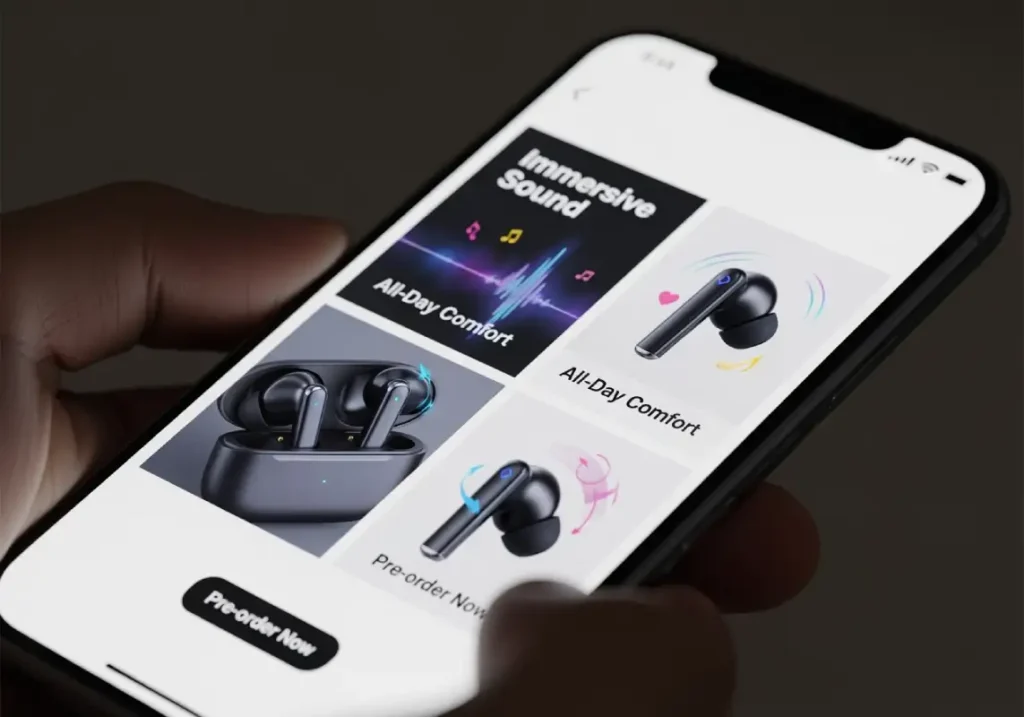
Video ads are a dynamic and highly engaging format that allows businesses to tell a more comprehensive story, demonstrate products, or showcase their brand personality. They are increasingly popular, especially considering that every month, over 1.25 billion users watch videos on Facebook, devoting nearly 50% of their app time to video viewing.
How they work: Video ads play automatically in users’ feeds, grabbing attention with motion and sound (though often viewed sound-off initially). They are excellent for driving engagement, explaining complex products, building brand loyalty, and increasing conversions. Video advertising drives high audience engagement, making them a powerful tool in your advertising arsenal.
Specifications & Best Practices:
- Length: Keep videos concise. Facebook suggests less than 15 seconds for optimal performance, especially for Stories and Reels placements. While Facebook allows videos up to 240 minutes, shorter videos tend to have higher completion rates.
- Sound-Off Design: Design your videos to be effective even without sound, as 85% of video views occur in mute. Use clear visuals, on-screen text, and captions to convey your message.
- Aspect Ratios: Common aspect ratios include 1:1 (square), 4:5 (vertical), and 9:16 (full vertical for Stories/Reels).
- File Size: Maximum file size is 4 GB.
- Hook: Start with a strong visual hook in the first few seconds to capture attention immediately.
Advantages: High engagement rates, effective for storytelling and product demonstration, can significantly increase brand recall and conversion rates. Video ads can generate more views and clicks and be 270% more effective at converting than photo ads. Disadvantages: More time-consuming and costly to produce than image ads, requires careful optimization for sound-off viewing.
Carousel Ads: Showcasing Multiple Products or Features
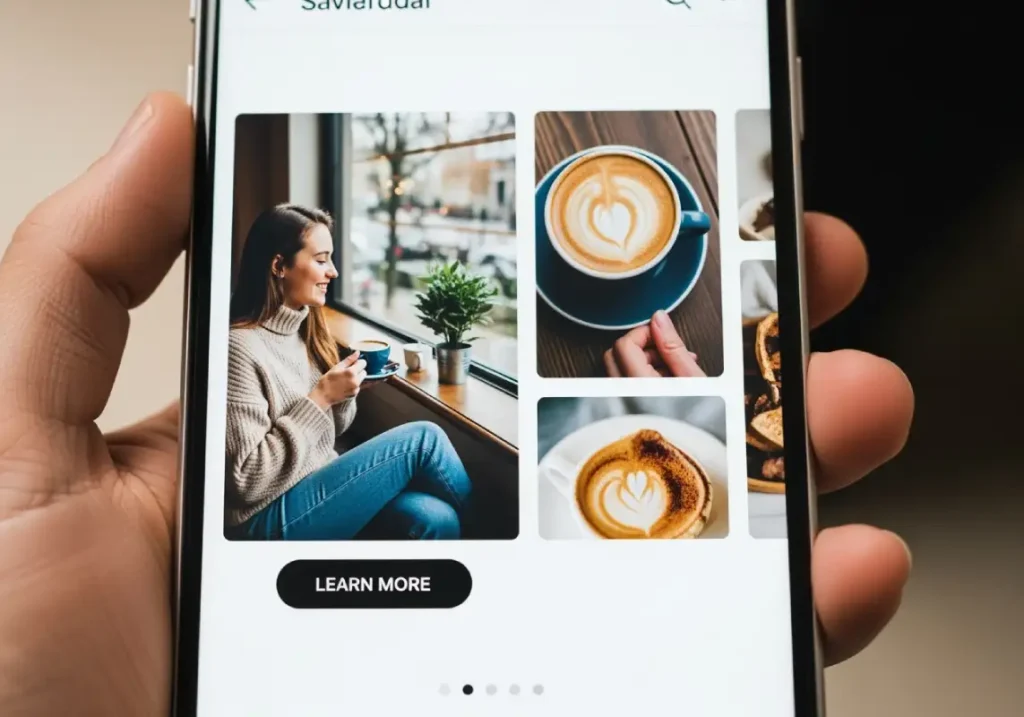
Carousel ads allow you to display up to 10 images or videos within a single ad unit, each with its own headline, description, and link. Users can swipe horizontally through the cards, making it an interactive and versatile format.
How they work: This format is perfect for showcasing multiple products, highlighting different features of a single product, telling a sequential story, or guiding users through a process. Each “card” in the carousel can link to a different landing page, offering a highly customizable user journey. They are particularly effective for e-commerce businesses. We’ve seen how Facebook Carousel Ads can be a game-changer for online retailers.
Specifications & Best Practices:
- Cards: Use 2 to 10 cards (images or videos).
- Aspect Ratio: 1:1 (square) is recommended for both images and videos.
- Unique Content: Each card should offer unique value, whether it’s a different product, feature, or a continuation of a story.
- Visual Cues: Use visual cues (e.g., arrows, partial images on the edge) to encourage users to swipe.
- CTAs: Customize the CTA for each card if necessary, linking to specific product pages or relevant content.
Advantages: Highly engaging, allows for showcasing variety, effective for storytelling, can lead to lower cost-per-conversion and cost-per-click compared to single image ads. Disadvantages: Requires more creative assets than single image/video ads, can be less effective if the cards aren’t cohesive or compelling.
Collection Ads: Creating an Instant Storefront
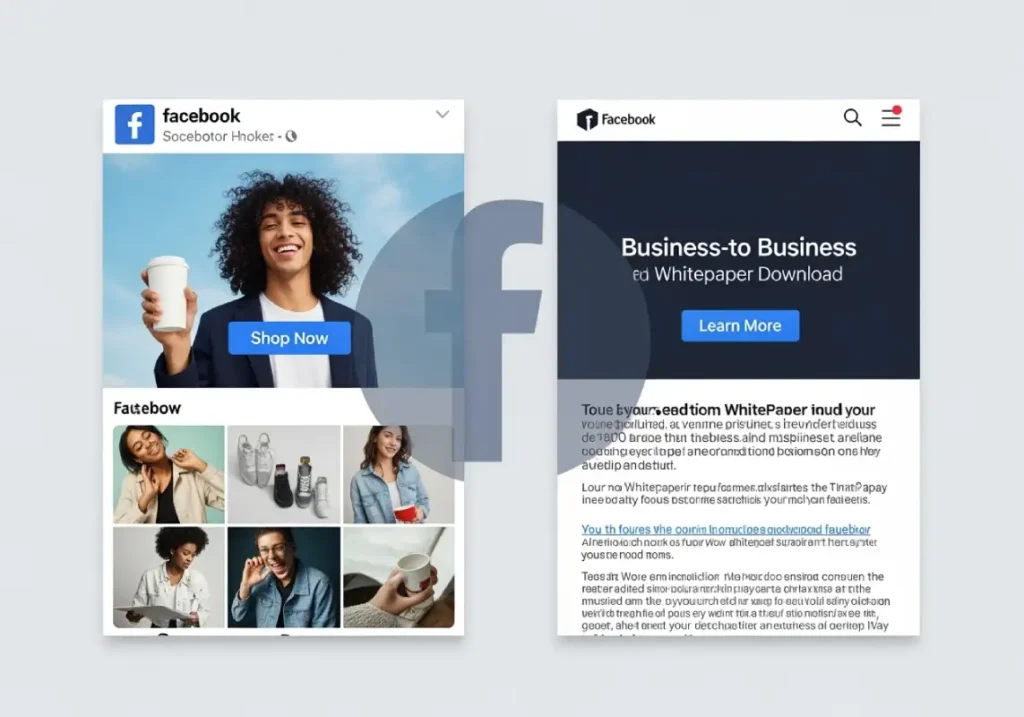
Collection ads are a mobile-only, full-screen ad format designed to streamline the shopping experience directly within Facebook. When a user taps on a collection ad, it opens an Instant Experience (formerly Canvas) that displays a visually immersive product catalog.
How they work: This format is ideal for e-commerce businesses looking to drive product findy and sales. It allows users to browse multiple products from your catalog without leaving the Facebook app, creating a seamless “window shopping” experience. Users can then click on individual products to be taken to your website for purchase.
Specifications & Best Practices:
- Mobile-Only: Designed exclusively for mobile devices.
- Instant Experience: The ad leads to a full-screen Instant Experience, which is a customizable landing page within Facebook.
- Product Catalog: Requires a product catalog to be uploaded to Meta Business Manager.
- Dynamic Selection: Facebook’s algorithms can dynamically select and display products from your catalog based on user relevance.
- Visuals: Use a strong hero image or video at the top of the collection ad to grab attention.
Advantages: Highly visual and immersive, reduces friction in the shopping journey, excellent for e-commerce, and can showcase a wide range of products. Disadvantages: Mobile-only, requires a product catalog, may be less suitable for businesses not selling physical products.
Slideshow Ads: Lightweight Motion for All Connections
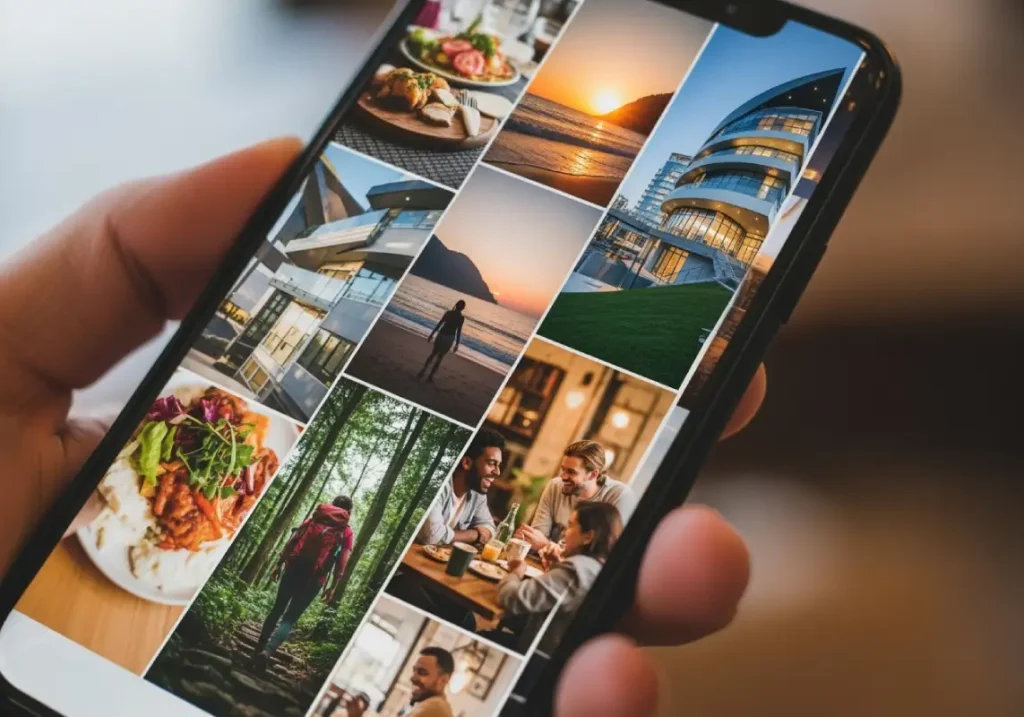
Slideshow ads offer a video-like experience using a series of static images (3 to 10) or a single video clip, accompanied by text and optional music. They are essentially a simplified, lighter version of video ads.
How they work: This format is particularly useful for advertisers in regions with slower internet connections, as slideshow ads use five times less data than full video ads. They are also a cost-effective way to create engaging motion-based content without the complexities of full video production. You can use them to tell a story, highlight features, or create a dynamic sequence of visuals.
Specifications & Best Practices:
- Images/Video: Use 3 to 10 images or a single video clip.
- Aspect Ratio: Recommended 1:1 (square) for images.
- Music: Add royalty-free music to improve the experience.
- Transitions: Use Facebook’s built-in transitions between slides.
- Targeting: Consider targeting audiences in areas with limited bandwidth for maximum impact.
Advantages: Low data usage, cost-effective, easy to create, provides a dynamic visual experience similar to video without the high production cost. Disadvantages: Less dynamic than full video, limited in complex storytelling compared to a dedicated video.
Advanced and Interactive Formats for Deeper Engagement
Beyond the core formats, Facebook offers a suite of advanced and interactive ad types designed to create more immersive experiences, streamline lead generation, and deliver highly personalized content.
Instant Experience Ads: Full-Screen Immersive Journeys
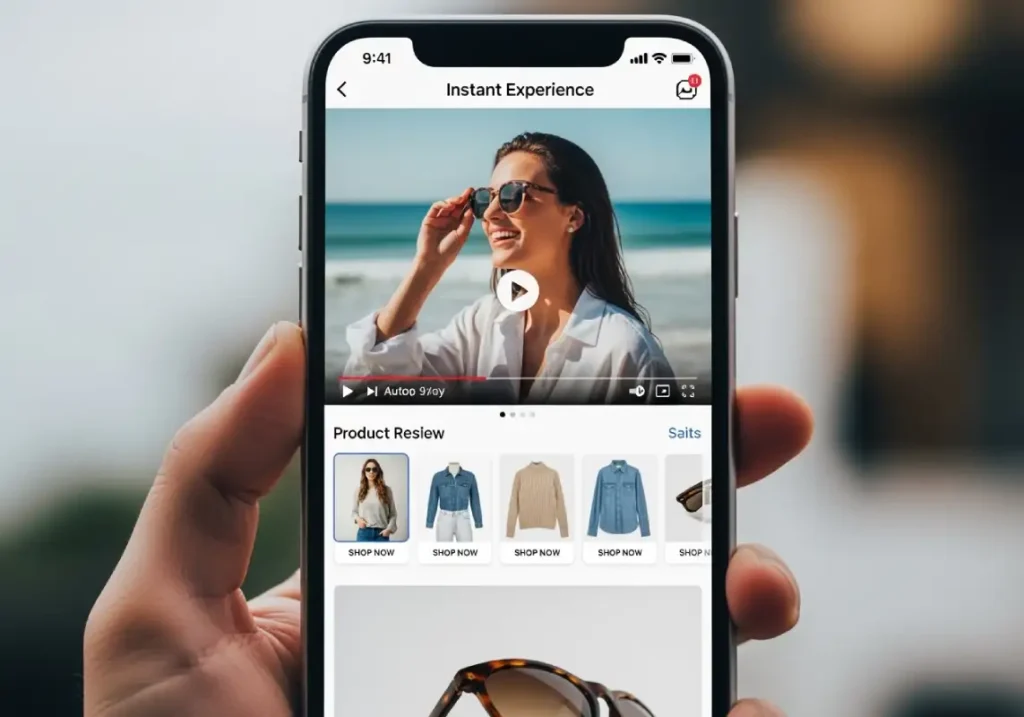
Formerly known as Canvas Ads, Instant Experience ads are a full-screen, mobile-optimized ad format that loads significantly faster than external mobile websites. They allow users to engage with rich, interactive content directly within the Facebook app.
How they work: When a user clicks on an Instant Experience ad, they are taken to a customizable, full-screen landing page within Facebook. This page can include a combination of images, videos, carousels, text blocks, and tagged products. Users can swipe, tilt, and zoom to explore the content, creating a highly immersive and interactive brand experience. Facebook reports that Instant Experience ads load 15 times faster than external mobile sites, significantly reducing bounce rates due to slow loading.
Specifications & Best Practices:
- Mobile-Optimized: Exclusively for mobile devices.
- Components: Can include various components like photos, videos, carousels, text, and buttons. Facebook recommends using five to seven components for optimal engagement.
- Templates: Use Facebook’s pre-made templates (e.g., Instant Storefront, Instant Lookbook) to simplify creation.
- Storytelling: Design the Instant Experience to tell a cohesive and engaging story.
Advantages: Highly immersive and interactive, fast-loading, keeps users within the Facebook ecosystem, excellent for rich storytelling and product showcases. Disadvantages: Mobile-only, can be complex to design effectively, requires more creative assets and planning.
Lead Ads: Streamlining Information Capture
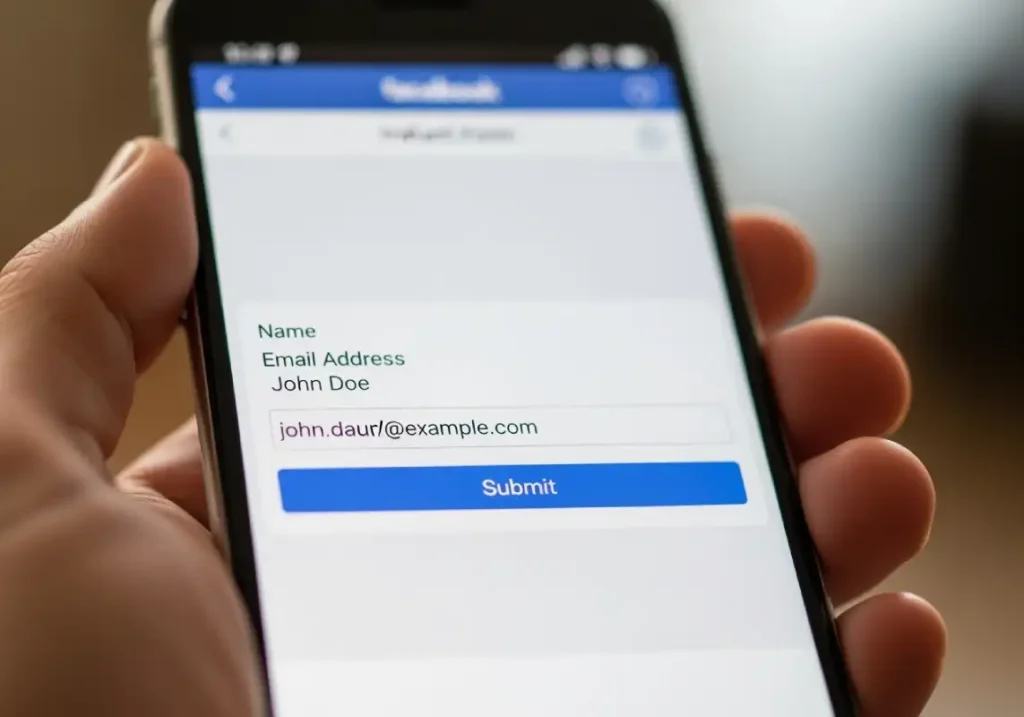
Lead ads are designed to make lead generation as frictionless as possible. They allow businesses to collect information from potential customers directly within the Facebook platform using pre-filled forms.
How they work: When a user clicks on a lead ad, an “Instant Form” pops up. This form is often pre-populated with the user’s contact information (name, email, phone number) from their Facebook profile, requiring minimal effort from the user. This significantly reduces friction and improves conversion rates for lead capture. Businesses can customize the questions to qualify leads further and integrate the data directly with their CRM systems.
Specifications & Best Practices:
- Mobile-First: Primarily designed for mobile devices.
- Instant Form: Uses Facebook’s native Instant Form for data collection.
- Custom Questions: Add custom questions to gather specific information relevant to your business.
- Privacy Policy: A link to your privacy policy is required.
- CRM Integration: Integrate with your CRM to automatically transfer lead data for immediate follow-up. Using CRM software can cut the cost of your leads in half.
- Incentives: Offer valuable incentives (e.g., e-books, discounts, free trials) to encourage form completion.
Advantages: High conversion rates due to pre-filled forms and low friction, mobile-friendly, direct integration with CRM, effective for collecting newsletter sign-ups, quote requests, or demo bookings. Disadvantages: Leads might be lower quality if not properly qualified, requires prompt follow-up to convert leads effectively.
Dynamic Ads: Automated and Personalized Retargeting
Dynamic ads, also known as Dynamic Product Ads (DPAs), are powerful for e-commerce businesses. They automatically show personalized ads to users based on their past interactions with your website or app.
How they work: To use dynamic ads, you need to upload your product catalog to Meta Business Manager and install the Meta Pixel on your website. The pixel tracks user behavior (e.g., viewing a product, adding to cart, making a purchase). Facebook then uses this data to automatically generate and serve highly relevant ads featuring the exact products a user has shown interest in, or similar items. This is exceptionally effective for retargeting abandoned carts or showcasing new products to interested segments. This allows for highly personalized advertising at scale. For a comprehensive understanding of all the different Facebook ad types for predictable growth, exploring dynamic ads is crucial.
Specifications & Best Practices:
- Product Catalog: Essential for dynamic ads to pull product information.
- Meta Pixel: Crucial for tracking user behavior and enabling retargeting.
- Event Tracking: Configure standard and custom events in the Meta Pixel for precise targeting.
- Audience Segmentation: Create custom audiences based on specific actions (e.g., “viewed content,” “added to cart but didn’t purchase”).
- Creative: While dynamic, you can still customize ad copy and templates.
Advantages: Highly personalized and relevant, excellent for retargeting and driving conversions, efficient for large product catalogs, automated ad creation. Disadvantages: Requires technical setup (product catalog, Meta Pixel), less suitable for businesses without a large product inventory.
Messenger Ads: Sparking One-on-One Conversations
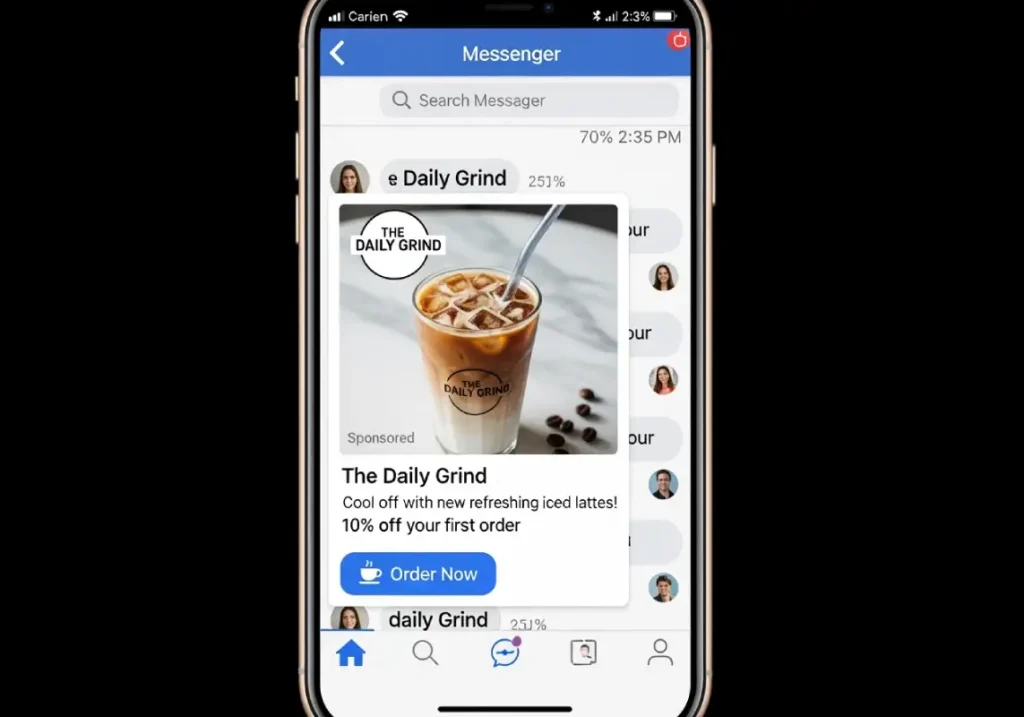
Messenger ads appear within the Facebook Messenger app, allowing businesses to initiate or continue one-on-one conversations with potential customers. This taps into the growing trend of conversational marketing.
How they work: There are a few types of Messenger ads:
- Click-to-Messenger Ads: These appear in Facebook/Instagram feeds and, when clicked, open a conversation with your business in Messenger.
- Sponsored Messages: These are sent directly to users who have previously interacted with your business in Messenger.
- Messenger Inbox Ads: These appear as ads in the Messenger app’s inbox tab.
These ads are valuable for lead nurturing, customer support, answering FAQs, and driving direct sales conversations. They leverage the popularity of the platform, as Facebook Messenger is used by 46% of the United States population.
Specifications & Best Practices:
- Placement: Facebook Messenger inbox, Messenger Stories, or as click-to-Messenger ads in Facebook/Instagram feeds.
- Automated Responses: Set up automated greetings and quick replies to manage initial interactions.
- Human Handoff: Ensure a seamless transition to a human agent for complex queries.
- Personalization: Leverage past conversation history to personalize interactions.
Advantages: Direct and personal communication, high engagement rates, excellent for lead nurturing and customer service, can build strong customer relationships. Disadvantages: Requires resources for managing conversations, potential for spamming if not used thoughtfully.
Stories, Reels, and AR Ads: Tapping into Modern Trends
Facebook, Instagram, and Messenger Stories, along with Facebook Reels, represent a significant shift towards short-form, vertical video content. These immersive, full-screen formats are increasingly popular and offer unique advertising opportunities.
How they work:
- Stories Ads: These are full-screen, vertical ads that appear between users’ organic Stories. They can be images, videos, or carousels. Stories offer a lot of freedom for expression, allowing for interactive elements like polls and emojis. As with Instagram, Facebook Stories are an increasingly popular form of entertainment and present a real opportunity for ad placement.
- Reels Ads: Similar to Stories, Reels ads are short, entertaining vertical video ads that appear within Facebook Reels. They are designed to blend seamlessly with organic content.
- Augmented Reality (AR) Ads: A newer, highly interactive format that allows users to engage with your brand using AR filters and effects. Users can “try on” products, play games, or interact with branded elements using their phone’s camera. Snapchat pioneered this style of ad, and it has proven benefits for engagement and campaign effectiveness.
Specifications & Best Practices:
- Vertical Format: Optimize all creative for 9:16 aspect ratio (full-screen vertical).
- Quick Pacing: Content should be and attention-grabbing, especially for video.
- Interactive Elements: Use stickers, polls, and other interactive features to boost engagement.
- Authenticity: Aim for a native, user-generated feel to blend seamlessly with organic content.
- Sound: While sound-off is common, many users watch Stories/Reels with sound, so consider audio.
Advantages: Highly engaging and immersive, taps into popular content consumption trends, excellent for brand building and product findy, AR offers unique interactive experiences. Disadvantages: Requires vertical-specific creative, content needs to be highly engaging to prevent skips, AR ads can be complex to produce.
A Strategic Framework for Optimizing Facebook Ad Types
Choosing the right Facebook ad type is not a one-time decision; it’s a strategic process that requires careful planning, execution, and continuous optimization.
Matching Ad Formats to Your Marketing Funnel

Effective advertising aligns ad formats with the different stages of the customer journey, often conceptualized as a marketing funnel:
- Top-of-Funnel (TOFU) – Awareness: At this stage, the goal is to introduce your brand to a broad audience and generate initial interest.
- Best Formats: Image Ads, Video Ads (short, engaging), Stories Ads, Reels Ads. These formats are excellent for broad reach and capturing attention. Consider focusing on Facebook Brand Awareness as your objective.
- Middle-of-Funnel (MOFU) – Consideration: Here, you want to deepen engagement and provide more information to users who have shown some initial interest.
- Best Formats: Video Ads (longer, more informative), Carousel Ads (showcasing features/benefits), Instant Experience Ads (immersive content), Slideshow Ads. These allow for more detailed storytelling and interaction.
- Bottom-of-Funnel (BOFU) – Conversion/Sales: The objective is to drive specific actions, such as purchases, sign-ups, or lead submissions.
- Best Formats: Dynamic Ads (retargeting), Collection Ads (direct shopping), Lead Ads (frictionless lead capture), Offer Ads (promotions). These formats are designed to convert interested prospects into customers.
By mapping your ad formats to the funnel, you ensure that your messaging and creative are appropriate for where the customer is in their journey, increasing the likelihood of a positive response.
A Step-by-Step Guide for Optimizing Facebook Ad Types
Optimizing your Facebook ad campaigns is an ongoing process. Here’s a systematic approach:
- Define Your Goal: Before choosing any ad type, clearly articulate your campaign objective (e.g., increase website traffic, generate leads, boost sales). This will guide your format selection.
- Understand Your Audience: Who are you trying to reach? Their demographics, interests, and online behavior will influence which formats resonate most. For example, a younger, mobile-native audience might respond better to Stories and Reels.
- Select the Right Format: Based on your goal and audience, choose the ad format that best supports your objective. Don’t be afraid to test multiple formats.
- Create Compelling Creative: This is where your ad truly shines. Invest in high-quality images, engaging videos, and well-designed interactive elements. Ensure your visuals are optimized for the chosen placement.
- Write Engaging Ad Copy: Your copy should be concise, benefit-oriented, and include a strong call-to-action. Tailor the tone and message to your audience and the ad format.
- A/B Testing: This is critical for optimization. Test different ad formats, visuals, copy, headlines, and CTAs to see what performs best. Facebook’s A/B testing tools in Facebook Ads Manager allow for systematic experimentation. For more insights on this, check out our guide on Facebook Ad Testing.
- Analyze Performance: Regularly monitor your campaign metrics (KPIs discussed below). Identify what’s working and what isn’t, and use these insights to refine your strategy.
Key Best Practices for Optimizing Facebook Ad Types
Regardless of the specific format, adhering to general best practices will significantly improve your Facebook ad performance:
- Mobile-First Design: A vast majority of Facebook users access the platform via mobile. Ensure all your ad creatives are optimized for mobile viewing, including aspect ratios, text readability, and fast loading times.
- High-Quality Visuals: Blurry images or pixelated videos will undermine your message. Invest in professional-grade visuals that stand out in a crowded feed. Explore our Facebook Ad Examples for inspiration.
- Clear and Concise Copy: Get straight to the point. Users scroll quickly, so your message needs to be understood at a glance.
- Strong Call-to-Action (CTA): Tell users exactly what you want them to do. Use action-oriented language and make the CTA button prominent.
- Audience Targeting: Leverage Facebook’s robust targeting options, including demographics, interests, behaviors, and custom audiences. Precise Facebook Ad Targeting is key to reaching the right people.
- Placement Optimization: While automatic placements are convenient, consider manually selecting placements (e.g., Feed, Stories, Audience Network) if specific formats perform better in certain areas. For more on this, read our article on Facebook Ad Placement.
- Continuous Testing: Never stop testing. Audiences and trends change, so regularly experiment with new creatives, copy, and formats. Avoid common pitfalls by learning from Facebook Ad Mistakes.
Measuring Success Across Different Ad Formats
Effective measurement is the cornerstone of successful Facebook advertising. Without understanding how your ads are performing, optimization becomes a guessing game.
Key Performance Indicators (KPIs) to Monitor
To gauge the effectiveness of your Facebook ad campaigns across different formats, focus on these essential KPIs:
- Cost Per Click (CPC): The average cost you pay for each click on your ad. A lower CPC generally indicates more efficient ad spend. The average Facebook ad CPC is $0.60.
- Click-Through Rate (CTR): The percentage of people who saw your ad and clicked on it. A higher CTR suggests your ad creative and copy are highly engaging and relevant to your audience.
- Conversion Rate: The percentage of people who completed a desired action (e.g., purchase, sign-up) after clicking your ad. This is crucial for sales and lead generation objectives.
- Cost Per Acquisition (CPA): The average cost to acquire a customer or complete a specific conversion. A lower CPA means you’re acquiring customers more efficiently.
- Return On Ad Spend (ROAS): The revenue generated for every dollar spent on advertising. This is a vital metric for understanding the profitability of your campaigns.
- Engagement Rate: Measures how often people interact with your ad (likes, comments, shares, video views). High engagement can indicate strong brand resonance and organic reach potential.
Regularly review these metrics within Meta Ads Manager to identify trends, pinpoint high-performing ads, and make data-driven decisions for optimization.
The Role of the Meta Pixel in Tracking and Optimization
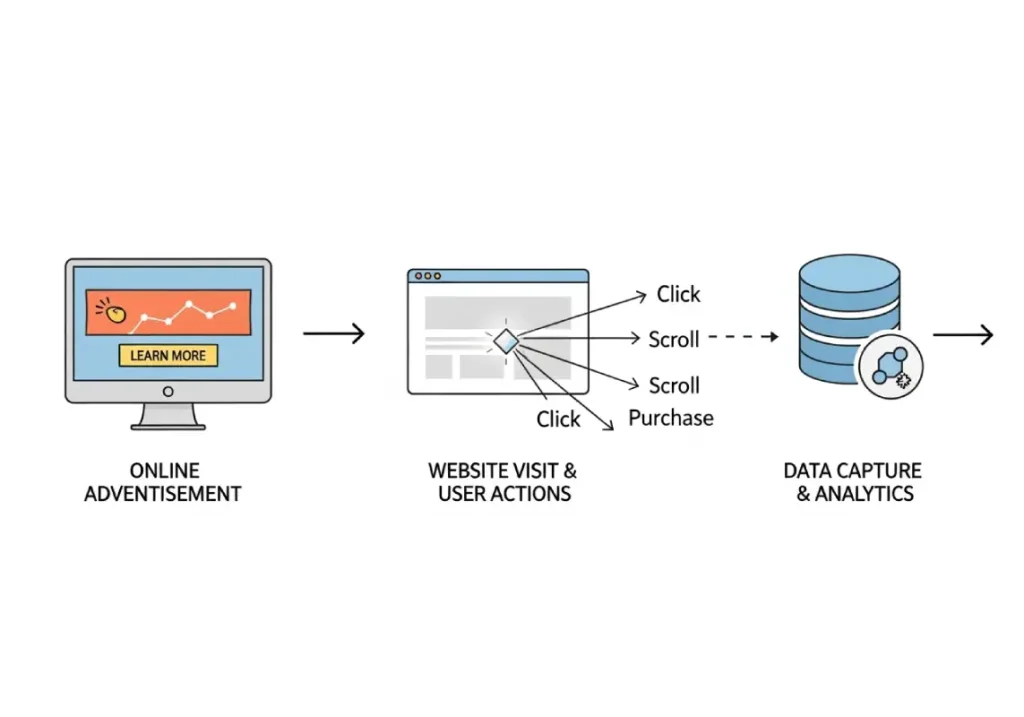
The Meta Pixel (formerly Facebook Pixel) is a crucial piece of code that you install on your website. It acts as a bridge between your Facebook ads and your website, providing invaluable data for tracking and optimization.
How it works:
- Conversion Tracking: The Pixel tracks various actions (events) users take on your website after seeing or clicking your Facebook ad, such as page views, add-to-carts, purchases, and lead form submissions. This data is essential for measuring conversion rates and CPA.
- Custom Audiences: The Pixel allows you to create Custom Audiences based on website visitors. For example, you can target ads specifically to people who visited a certain product page but didn’t buy. This is fundamental for Facebook Retargeting.
- Lookalike Audiences: Once you have a Custom Audience (e.g., your past purchasers), you can use the Pixel data to create Lookalike Audiences. These are new audiences that share similar characteristics with your existing valuable customers, helping you expand your reach to highly relevant prospects.
- Dynamic Ads: As discussed, the Pixel is indispensable for dynamic ads, enabling Facebook to show personalized product recommendations based on browsing history.
- Optimization: The data collected by the Pixel allows Facebook’s algorithm to optimize your ad delivery, showing your ads to people who are most likely to complete your desired action, improving your campaign’s efficiency and ROI.
Installing and properly configuring the Meta Pixel is a non-negotiable step for any business serious about running effective Facebook ad campaigns. It provides the intelligence needed to understand your audience, track performance, and continuously refine your advertising strategy.
Frequently Asked Questions about Facebook Ad Types
What is the most effective Facebook ad format?
There isn’t a single “most effective” Facebook ad format; effectiveness is highly dependent on your specific campaign objective and target audience.
- For brand awareness and engagement: Video ads and Stories/Reels ads often perform exceptionally well due to their dynamic and immersive nature.
- For e-commerce sales and product showcasing: Carousel ads and Collection ads are highly effective for displaying multiple products or features.
- For lead generation: Lead ads are designed for frictionless information capture directly within the platform.
- For retargeting: Dynamic ads are best in their ability to deliver personalized product recommendations.
The key is to test different formats for your unique business and audience. What works for one company might not work for another.
How much do Facebook ads cost?
The cost of Facebook ads is determined by an auction system, where advertisers bid for ad impressions. Several factors influence pricing:
- Bidding Strategy: Whether you bid for clicks, impressions, or conversions.
- Audience Competition: Highly sought-after audiences will have higher costs due to increased competition from other advertisers.
- Ad Quality and Relevance: Facebook assigns a relevance score to your ads. High-quality, relevant ads that resonate with the audience tend to cost less.
- Placement: Some placements (e.g., News Feed) can be more expensive than others (e.g., Audience Network) due to higher demand.
- Seasonality: Costs can fluctuate based on seasonal demand, such as holiday shopping periods.
While the average Facebook ad cost per click (CPC) is $0.60, your actual costs will vary. It’s crucial to monitor your KPIs (like CPC and CPA) to ensure your ad spend is efficient.
How do I choose between different Facebook ad types?
Choosing the right Facebook ad type involves a systematic approach:
- Start with Your Objective: Clearly define what you want to achieve (e.g., awareness, traffic, leads, sales). This is the most important guiding principle.
- Consider Your Audience: Think about where your audience spends their time on Facebook (Feed, Stories, Messenger) and what types of content they prefer. Are they more receptive to quick, engaging videos or detailed product showcases?
- Evaluate Your Creative Resources: Do you have high-quality video content, or are you better equipped to produce compelling images? Some formats require more advanced creative assets than others.
- Test and Iterate: Don’t put all your eggs in one basket. Start by testing a few relevant ad formats for your objective. Analyze the performance data, learn what resonates with your audience, and then scale up the most effective formats. Continuous A/B testing is vital for ongoing optimization.
Conclusion
Finding Your Perfect Ad Mix
Navigating the diverse world of Facebook ad formats can seem daunting, but it’s an essential skill for any business aiming for digital growth. We’ve explored the core formats, from the simplicity of image ads to the immersive experiences of Instant Experience ads, and the targeted power of dynamic ads. We’ve also digd into formats designed for modern trends, like Stories, Reels, and Messenger ads, emphasizing their role in engaging today’s digital consumer.
The key takeaway is that there’s no one-size-fits-all solution. The power of Facebook advertising lies in its versatility and the ability to tailor your approach to specific goals and audiences. By understanding each format’s strengths and weaknesses, aligning them with your marketing funnel stages, and diligently applying best practices, you can craft highly effective campaigns.
The journey to successful Facebook advertising is iterative. It’s about continuous optimization, driven by data from the Meta Pixel and a keen eye on your KPIs. The power of testing and iteration cannot be overstated; it allows you to refine your strategy, find what truly resonates with your audience, and ultimately achieve your business objectives. By finding your perfect ad mix, you’re not just advertising; you’re building meaningful connections and driving tangible results.
Visit our Facebook Ad Agency page to learn how we can help you find your perfect ad mix and drive predictable growth.
